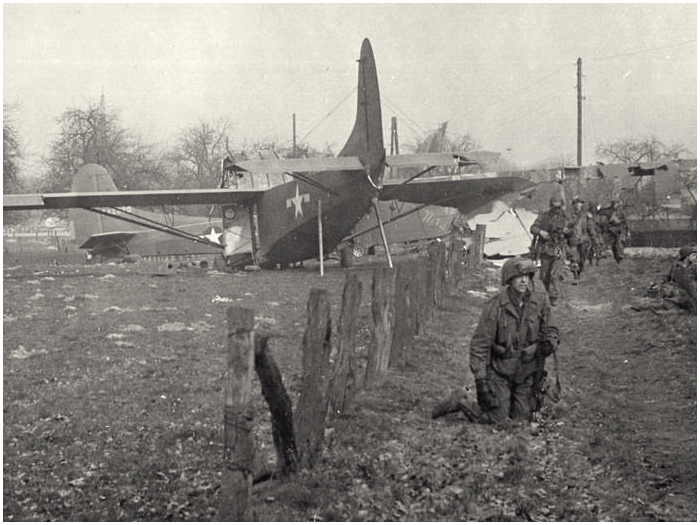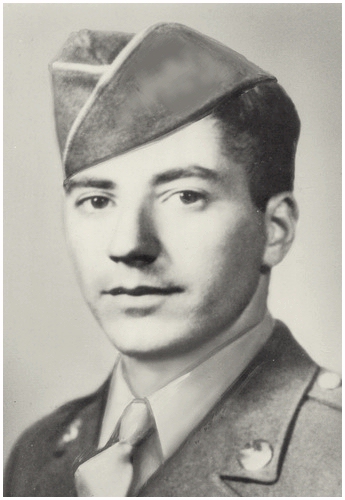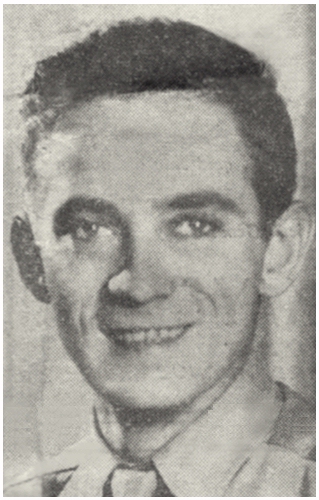
Preface
As mentioned before, on the Magraten cemetery lie more than 8300 young Americans.
They lost their lives, far from home, in a murderess world. Thanks to these men, who knew;
'if I fall, another will take my place', we are living in a free western world. The names
on the gravemarkers have no faces for the ordinary visitor. What did they look like, what
were their plans for the future 'after the war', we we'll never know, they rest for eternity
in Dutch soil. But not nameless. We, the free people, can silently stand at their grave and
thank them for their sacrifice.

Two boys, who
realize their freedom
Everyone that rests on Margraten deserves the highest decoration and is a true
hero in my eyes. And everyone should have their story on these pages. But I do not know their
story's, except for a few, which I like to share with you. As you wander between the graves,
you may come across six stones with golden lettering. These are the markers for the men
that got the highest decoration for valor, the 'Medal of Honor'.
In spite of that many Afro-Americans fought in the Second Worldwar,
not a single one was handed a Medal of
Honor. In 1993 the US Army ordered the Shaw University in Raleigh,
North Carolina, to investigate if racial segregation had anything to do with not giving the
Medal of Honor to black soldiers. After the investigation, it became clear that the segregation
played a big part in many cases. The Shaw University brought in 10 names of black Americans who
deserved, in their opinion, the Medal of Honor. Seven of these men were proposed to the Congress
in October, 1996, who gave their approval a month later.

De Medal
of Honor (US Army)
On January 13, 1997, the first Medals of Honor were handed out
by President William Clinton. Of the seven approved medals, there was only one
survivor alive, Vernon Baker. The other medals were given posthumous to the relatives.
Their six gravestones were adapted and given golden lettering.
Private First Class
Willy F. James, Jr.

One of the forgotten Afro-American heroes who was honored 52 years
later, was Willy F. James, Jr. Born March 18, 1920 in Kansas City, Missouri, Willy James
went in the US Army on September, 11, 1942. As a scout for the infantry, he was placed
with Company G, 413th Infantry Regiment of the 104th Infantry Division, 'The Timberwolves'.

The Award Combat
Infantry Badge.
April 8, 1945, sees Private First Class James as first scout near
Lippoldsberg in Germany. The target was to secure a bridgehead and to extend it.
As first scout, James was the first target for enemy fire. Despite the fire, James
did observations for an hour on the German positions. When James returned to his platoon,
he helped with the preparations of the attack on the enemy. Because of his knowledge of
the German positions, he led a attack on a few appointed targets. When the platoon commander
was critically injured, James didn't hesitate and tried to safe his commander. German
machinegun fire killed Wily James during this ordeal.
He was given posthumous the Bronze Star Medal, the Purple Heart,
the Army Good Conduct Medal, the European-African-Middle Eastern
Campaign Medal and the World War II Victory Medal (all pictured below)
and were added to the Award Combat Infantry Badge. And then in 1996, Willy F. James,
Jr was also given the Medal of Honor.
    
To inspire future generation in the US Army, James
his name was given to the army barracks of the 7th US. Army Reserve Command
(ARCOM) Reserve Center in Bamberg, Germany, on November 4, 2001.

Private 1st Class Willy F. James, Jr.
is buried at
Margraten on Plot P, Row 9, Grave 9.
Private George J.
Peters

During 'Operation Varsity' the 507th Parachute Infantry
Regiment of the 17th Airborne Division landed on March 24, 1945 near
Fluren, Germany, east of the river Rhine. One of these paratroopers was Private George J.
Peters, original from Cranston, Rhode Island and radio-operator of Company G.

Para's of the 17th
Airborne Division during 'Operation
Varsity'.
With ten others, Peters landed in a field that was covered
by a German machinegun which was protected by several riflemen. Within 75 yards
the paratroopers were an easy target. Peters realized that if nothing was done,
they all would get killed. He rose to his feet and ran towards the enemy position.
This action drew all the attention to Peters. German fire cut into Peters, which
brought him to the ground, halfway to the enemy positions. He scrambled again on his
feet and continued his assault. But he was hit again which made his legs useless. His
wounds forced him to crawl. When he reached the German positions close enough, he threw
some hand grenades in the machinegunpost. Two Germans were killed instantly and the riflemen
decided to pull back in the woods behind them. Peters sacrifice saved his comrades so they could
organize, equip themselves and to go after there goals. February 8th, 1946, George Peters
received posthumously the Medal of Honor.
 
Private George J. Peters iss buried at Margraten in Plot G, Row 17, Grave 8.
Private First Class
Walter C. Wetzel

Groupleader Private First Class Wetzel, of the anti-tank
Company of the 13th Infantry Regiment, 8th Infantry Division,
was standing guard on April 3, 1945 at his platoons commandpost in Birken,
Germany. It was early in the morning when he noticed some enemy action.
German troops were heading for his commandpost. He went into the house
and warned his comrades. After that, he opened up with his rifle. The Germans
returned fire from automatic weapons. In the dark, some Germans reach the post
and threw in two grenades through the window where Wetzel and others were hiding.
Walter Wetzel cried a warning and without hesitation jumped onto the grenades.
The explosion was absorbed by Wetzel his body. His wounds were lethal and Wetzel
died as a hero. His sacrifice saved many men in that room, and they were able to
hold of the German attack. Private First Class Walter C. Wetzel was granted posthumously
the Medal of Honor on February 26, 1946.
 
Private 1st Class Walter C. Wetzel rests
in Plot N, Row 18, Grave 10.
In Baumholder, Germany, the elementary school for American military
and civilian personal was named after Walter Wetzel. The remembrance of his sacrifice will
never be forgotten to the youth of tomorrow.
Click for the last page on the Medal
of Honor below.
|